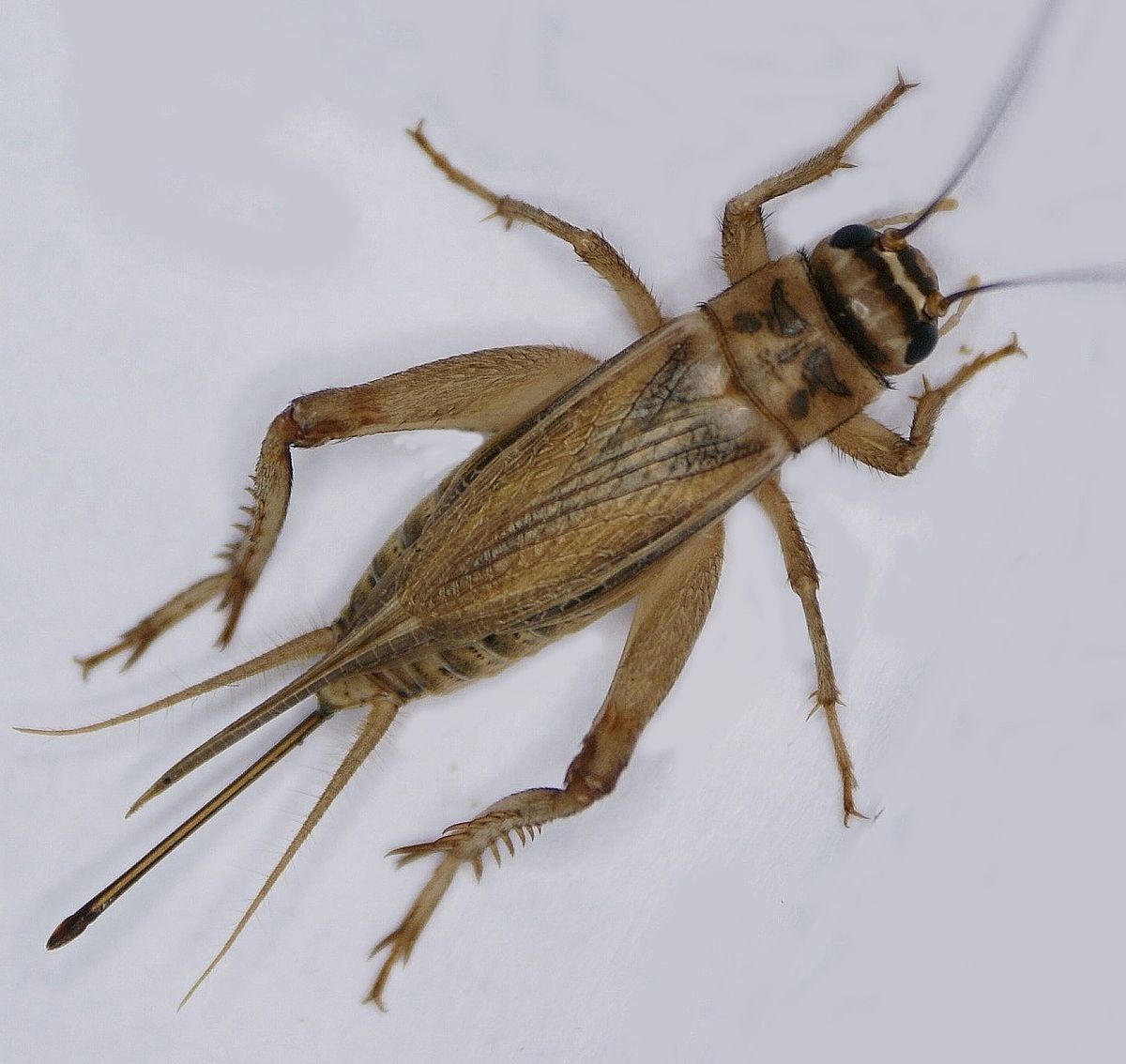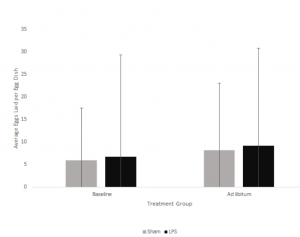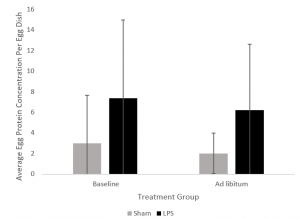4 How Immune Challenge and Food Availability Impact Reproductive Success
Kyli Calhoon and Isabella Miles
Abstract 
We investigated to what extent an immune challenge combined with food availability would impact the reproductive success of Acheta domesticus, commonly known as house crickets. We tested these variables through injection and control of the food (Orange Cube Cricket Diet) each cricket was given. There were a total of 4 treatment groups as we had two different food groups: baseline and ad libitum and two different immune challenges: Liposaccharides (LPS) and sham. There was a significant effect with regard to the immune challenge and the amount of eggs the cricket laid but there was no significant effect with regard to the food availability and amount of eggs. There was also no significance with immune challenge or food availability with regard to the quality of the eggs. This is important because it helps scientists understand how the immune challenges affect reproductive success, but also how food availability does not impact reproductive success.
Background
There has been a significant amount of research done into how food availability or an immune challenge can impact the reproductive success of house crickets. One study done had evidence that investing in the immune system can impair the growth, survival, and reproduction of female house crickets and another study provided evidence on how food availability impacted the reproductive success of marine copepods. Scientist Shelley Adamo led the discussion about how immune challenges impact the behavior of house crickets and Zachary Stahlschmidt researched the impact of food availability, but we decided to take these investigations a step further by combining the two variables to see how they impact the cricket. Our research is a further investigation of the research done by Susannah French and colleagues that explored if tradeoffs of reproduction when immune challenged were dependent (Facultative) or independent (Obligate) on resource availability.
Research Goals
Within our research, we were focusing on understanding how an immune challenge in combination with different food amounts impacts the reproductive output of house crickets. Our goal was to measure the number of eggs laid by each female cricket over the course of a week, and we also measured the concentration of protein in the eggs they laid as an assessment of egg quality.
Research Question: Is reproductive output independent, or dependent, on food availability when immune challenged?
Methods
Females in the experiment were randomly assigned a group based off of a random number generator. A factorial design was used to ensure that each immune-challenge group (sham or LPS) would have an equal amount of baseline or Ad libitum (unlimited) food for a total of 4 treatment groups. We used LPS extracted from S. marcescens to see how that would affect the crickets. We used the sham group to account for the immune challenge of the injection alone. The crickets were placed in a freezer for 4-6 minutes prior to injection and sterilized with 95% ethanol before and after the injection. Injections were done with a 50μL syringe.
For the experiment, we held the female crickets in individual containers with a coconut coir and orange cube. The orange cube was the cricket’s food and water source and the coconut coir was for the cricket to lay eggs. The top of the container was cut and mesh was glued there so that the cricket could get oxygen in the container.
The experiment ran for three weeks exactly, with each trial lasting one week. We exchanged the coconut coir and orange cube every other day, checking to see how the crickets were doing and accounting for the death among the crickets. The coconut coir was stored until after the three weeks were over, then we counted the amount of eggs in each petri dish.
We measured the protein content of the eggs with the Qubit protein assay kit, doing so because the protein quality was a good indicator for the measure of successful reproduction.
Results
In our experiment, we ran 3 different trials to test the impact of each treatment group (baseline/lps, baseline/sham, ad libitum/lps, ad libitum/sham) on egg production and quality in female Acheta Domesticus. Throughout these 3 trials, only 2 individuals survived a full 7 days; one individual was from the ad libitum/lps group and the other from ad libitum/sham group. Of the 48 individuals we injected, only 18 laid any eggs. Of those 18 individuals, we were only able to measure the egg protein concentration of 16. We found that neither immune challenge or food availability had a significant effect on the number of eggs laid. However, the egg protein concentration in LPS was significantly higher than sham groups, while there was no difference in egg protein concentration between food availability.


Interpretation and Significance
From our results, we found that neither the immune challenge or amount of food available had a significant effect on the reproductive output of the female crickets. This means across all treatment groups that we had (sham injection with baseline food, sham with unlimited food, LPS with baseline food, LPS with unlimited food), the differences in number of eggs laid and their protein concentrations were not due to the injection or food availability. In other words, the variation in numbers is due to other factors.
Our research had provided evidence that neither immune challenges nor food availability impact the reproductive success of A. domesticus in terms of the amount of eggs laid for each treatment group. On the other hand, in terms of quality of protein concentration, the LPS groups had significantly higher concentrations of protein meaning that immune challenges had an affect on the female crickets while food availability still had no effect. The significance of this research is that it allows scientists to better understand how immune challenges and food availability impact (or not impact) the reproductive success of the house cricket. This will also help scientists better understand how outside factors other than these two variables may impact how the cricket will behave.
Applications
This research provides additional insight into the impacts of food resources and immune challenges on reproduction in females. This has implications beyond the scope of research on insects. With climate change progressing and species being threatened, more research into this area will provide insight on how food limitations and possible immune challenges as a result of the increase in pollution could impact the future of a particular species. While pollution itself does not cause immune challenges, the new and ever changing environments that species are forced to live in pose new challenges, potentially leading to immune challenge.
